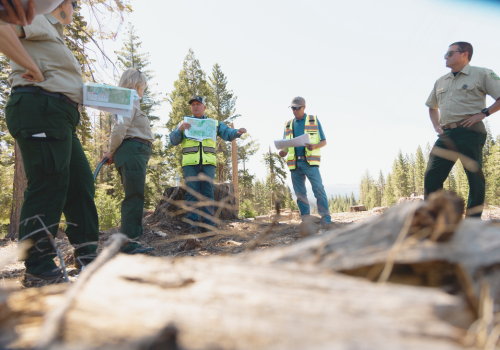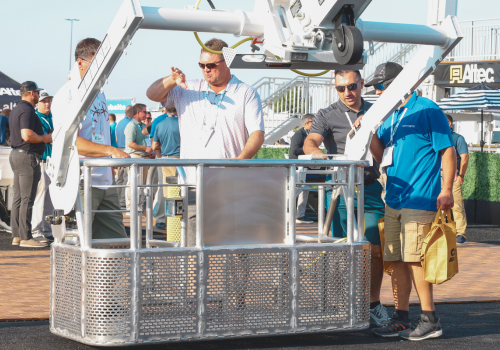Whether working several feet below ground or 100 feet in the air, power line workers have a challenging job. They can’t afford to be wearing inferior lineman work boots that compromise their comfort and safety. Here’s a quick rundown of the features to look for in lineman boots, along with some examples of the best lineman boots for working safely and productively.
Safety standards first
Utility line workers need a work boot that enhances their safety. OSHA’s standard for foot protection, 29 CFR 1910.136(a), requires an employer to ensure that employees wear protective footwear when working in areas that present danger of foot injury due to falling or rolling objects, piercing of the shoe sole, and electrical hazards. When it comes to utility line workers, that’s all the above.
When shopping for leather lineman work boots, look for the proper ASTM stamp of approval. ASTM F2413-18 is a work boot standard that defines requirements for everything from impact and puncture resistance to conductive protection and electrical hazard (EH) resistance.
Sometimes a utility company will require workers to wear footwear that meets the ASTM F1117 dielectric standard. This standard requires every boot or overshoe to be tested per the ASTM F1116 method; the boot or overshoe must pass a 20 kV test before it is released. Compliant footwear is considered secondary protection, providing additional isolation or insulation if a worker comes into accidental contact with energized electrical conductors, apparatus, or circuits.
In addition to providing an extra layer of protection, dielectric overshoes provide an additional layer of convenience. Linemen can slip their overshoes right over their regular boots. When removed from the hazardous environment, linemen can pull the overshoes back off and properly store them until needed again. Most linemen would rather spend the majority of their time in their regular work boots. Thus, a compliant pair of overshoes gives linemen an easy way to attain the protection they need, but only when they need it.
Features that improve functionality and comfort
In addition to meeting the necessary safety standard, the best linemen work boots also have the following characteristics:
- Good traction, even in wet conditions
- Impact protection
- Effective for climbing
- Taller height (8” to 10”) to fit snugly and provide good ankle support
- Arch support for durability and comfort
- Waterproof
- Insulated
Traction is an especially important feature to look for. With many of the most popular work boots, you’ll often hear the phrase “Vibram sole”. While there is a fascinating backstory to the Italian company and inventor behind this commonly used outsole, the bottom line is that a Vibram sole offers outstanding tread. Additionally, since it is made of rubber, it is waterproof and more flexible.
Impact protection is crucial for a lineman. Features like a steel toe protect from falling objects. A steel shank, positioned between the inner and outer soles, provides puncture resistance from the bottom of the shoe. Steel shanks also provide additional support when climbing ladders or poles. As long as the steel isn’t exposed, OSHA says there shouldn’t be a threat of electrical shock. That said, to be ultra-cautious, a lineman could also opt for nonmetallic (composite) protection which could include materials like nylon, plastic or fiberglass.
Raised heels can increase safety and comfort when climbing poles and using climbing gaffs. Raised heels also provide additional support when working on uneven terrain, which can be beneficial when hauling gear around.
Protection from the elements. Linemen work in all conditions. It’s important to have a boot that can handle rain and snow. Water-resistant boots repel water and may be all the protection you need. However, boots with a waterproof membrane may be useful when coming into contact with water for longer periods of time. A waterproof membrane will help keep feet dry, and a good design will still allow feet to breathe. Boots with extra insulation can also come in handy on those really cold days and nights on the job.
Best linemen boots for 2025
Quatro Dielectric Thermal Insulated Boots from Skellerup are manufactured with specially formulated insulating layers for electrical protection over the entire boot. These boots are fully waterproof with a full thermal sock liner for additional warmth and comfort.
Carhartt 8" Composite Toe Climbing Boots are designed for secure footing and all-weather versatility. This boot is also designed to be long-lasting with Carstrong reinforced fabric that prevents wear and tear. Other features include a Storm Defender waterproof breathable membrane, a TPU heel guard with Achilles flex joint for ankle stability and side-impact protection, a steel shank, and a cushioned polyurethane insole to absorb shock.
Honeywell Electriguard 20kV Dielectric Overboots are designed with integrated pull-up handles and rear kick-off lugs to make it easier to pull them on and off. The wider opening and nylon lining also enable accurate sizing and a more comfortable fit. Rated at 20,000 volts to protect workers from step potential, these boots also include a reflective stripe for an additional element of jobsite safety.
Wesco Highliner Lineman’s Boots are non-corrosive and double-ribbed with a slightly arched steel shank for improved comfort and support. To enhance performance, a Vibram sole improves traction, while a recessed metal breastplate offers protection from climbing spurs. Available in either 10” or 16”.
Ariat Powerline 8" Waterproof Composite Toe Work Boots are built for jobs that demand maximum durability and traction. They provide added stability with a tempered sheet shank, yet remain well-cushioned and comfortable. 3M Thinsulate Insulation adds warmth, but not extra weight. To further improve comfort, a removable Pro Performance insole adds cushioning and shock absorption, while shock-absorbing inserts are placed under both the heel and forefoot.
Thorogood 8" MAXwear Steel Toe Work Boots feature a MAXWear Wedge slip-resistant outsole for increased traction, while a fiberglass shank provides flexible support. The Ultimate Shock Absorption footbed and Poron comfort cushion insole enhance comfort. Durable Goodyear storm welt construction allows this boot to be resoled if necessary.
Steel Blue Portland 8" Lace-Up Boots are water-resistant, provide electrical hazard protection, and feature an ErgoDefender steel toe cap. The unique Ortho Rebound footbed is made from high-quality polyurethane to retain its shape and thickness, helping reduce foot fatigue. The durable TPU outsole provides a high tolerance against cuts, abrasion, splitting, and cracking, as well as a high resistance to most oils and chemicals.
Timberland Pro Boondock 8" Composite Toe Waterproof Work Boots are reinforced with Ever-Guard leather and molded rubber toe protectors for abrasion-resistant performance. Exclusive Anti-Fatigue Technology absorbs shock and returns energy to key zones of the foot. Molded, inverted cones support, collapse, and return energy in key pressure zones, and the cone structure uses less material for a lighter boot.
Subscribe to The Utility Expo monthly newsletter to receive more industry insights like this.
Read Next
The Best Electrical Lineman Work Gloves
Top Heavy-Duty Gloves for Working in Cold Weather












